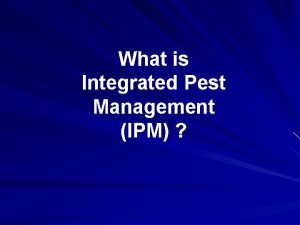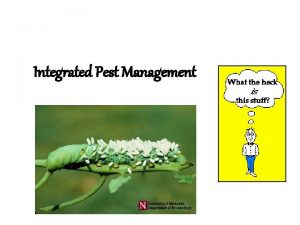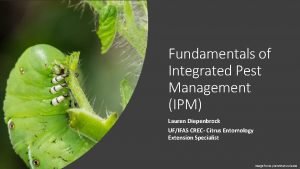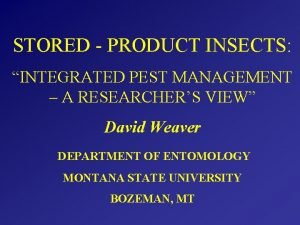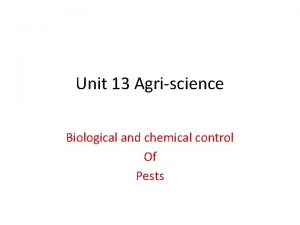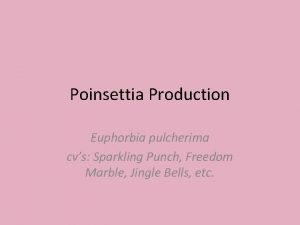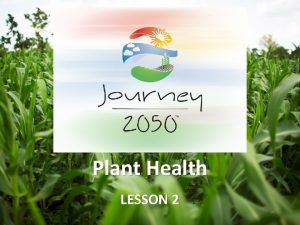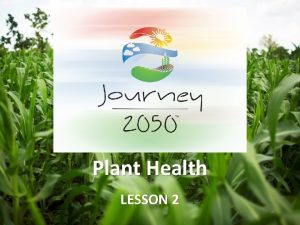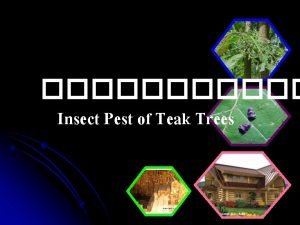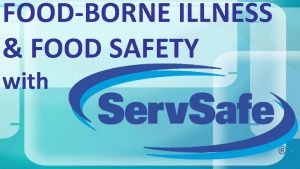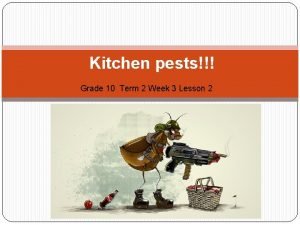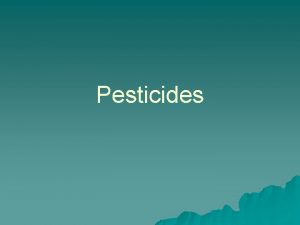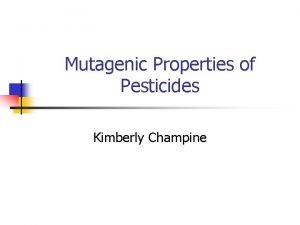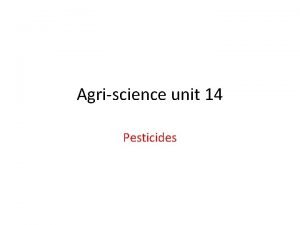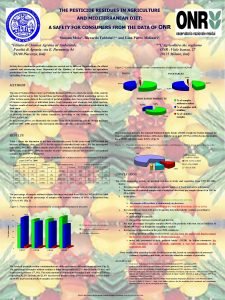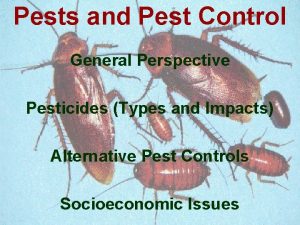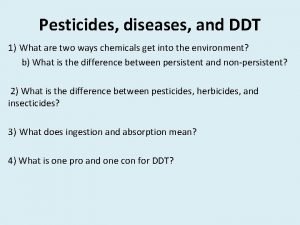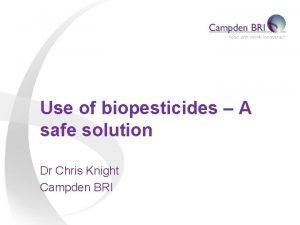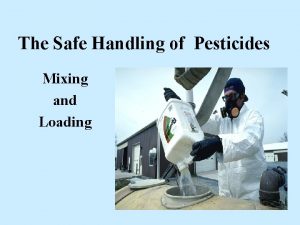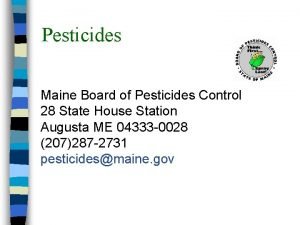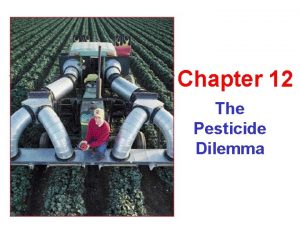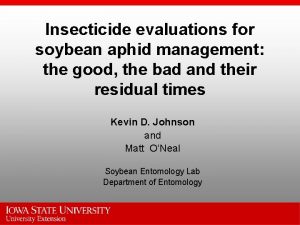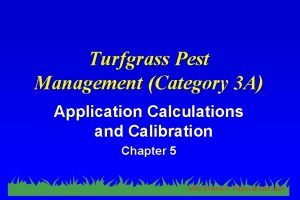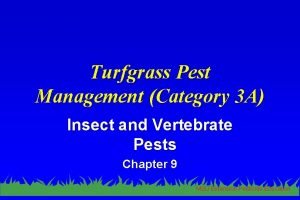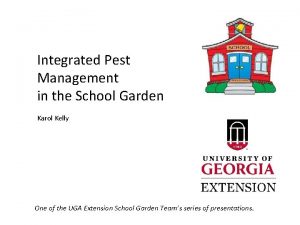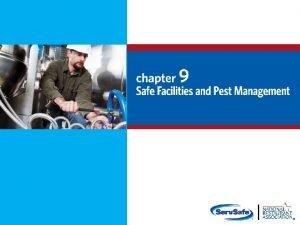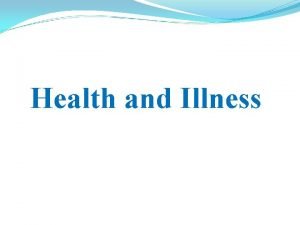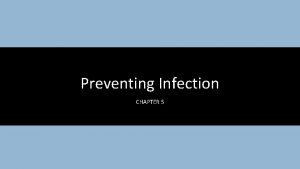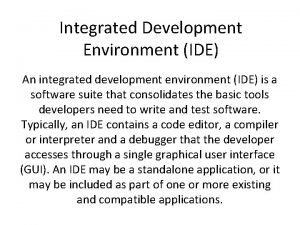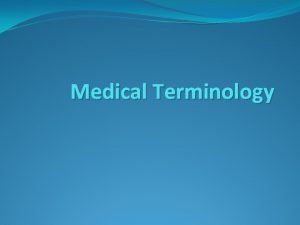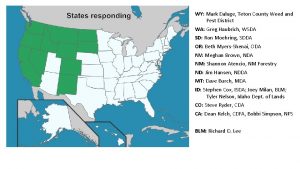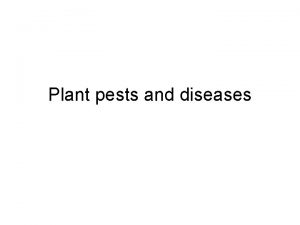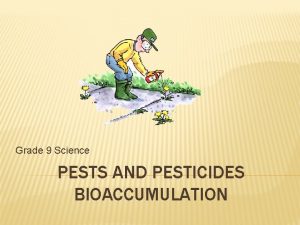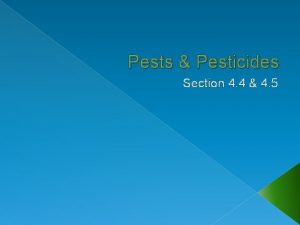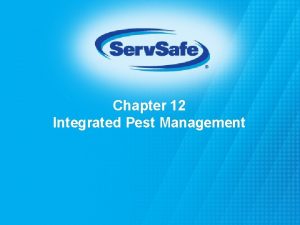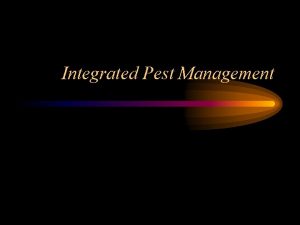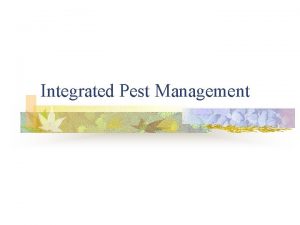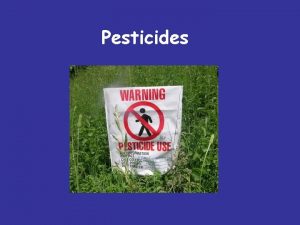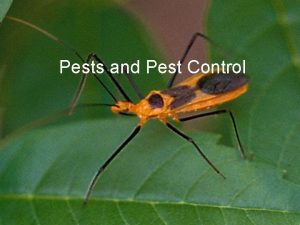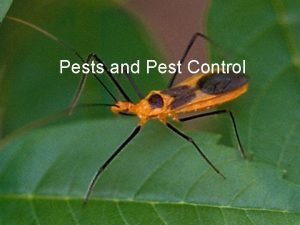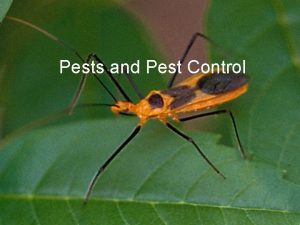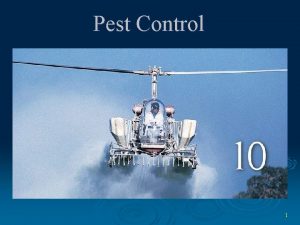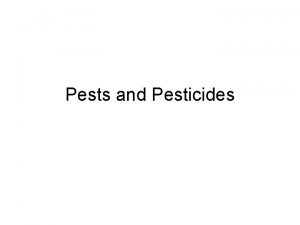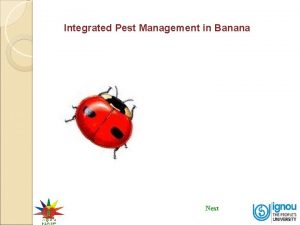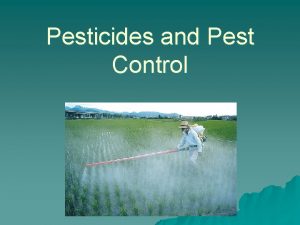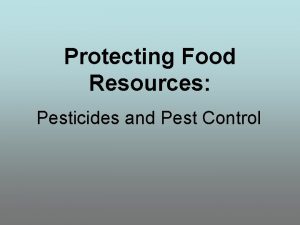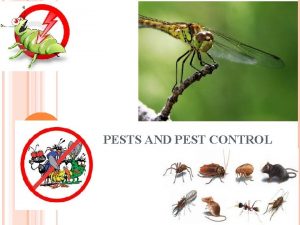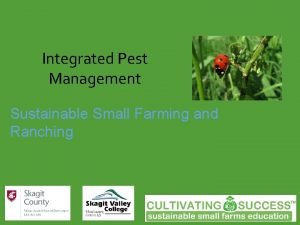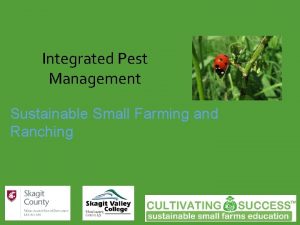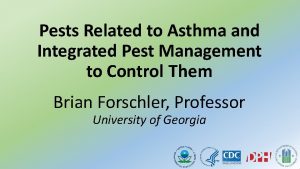Pesticides Pests Define Identify Integrated Pest Management Prevention




































- Slides: 36

Pesticides Pests Define Identify Integrated Pest Management Prevention Cultural Biological Chemical Physical Attracting Beneficials Control Yard Pests Responsibly

Pesticide Consequences Synthetic chemical pesticides were introduced in the 1940’s to control agricultural pests; unfortunately there were some unexpected consequences… n Trace residues in food n Environmental impacts n Pests developed resistance

Cycle of Pesticide Dependency Many synthetic chemical pesticides are broad-spectrum, killing not only target pests but also beneficial organisms that serve as natural pest-control systems. NO natural controls Pathogen resistance Dependence on chemical pesticides

In the days following a pesticide treatment, smaller bodied pests reproduce faster than larger predatory insects. By killing off beneficial insects, pest populations flourish. After Thomas Weissling

What is a Pest, really? n Pest- plant, animal, or other organism that is out of place n è Diseases, Weeds, Insects, Reptiles, Mammals, Arthropods Of all insect species in the world, less than 1 % are considered pests Am I a Pest? This depends on where I am feeding: in the vegetable garden or the butterfly garden.

Environmental Stresses Many environmental effects are mistakenly treated as pest problems. n n n Drought Nutrient deficiency Variations in p. H Mechanical damage Cold damage Excessive water An excess of soluble fertilizer or fertilizer burned this tomato plant.

Integrated Pest Management (IPM) n n n IPM is the coordinated use of pest and environmental information and available pest control methods To prevent unacceptable levels of pest damage by the most economical means With the least possible hazard to people, property and the environment

Principles of IPM Sustainability -capable of being maintained at length without losing in power or quality over time Prevention Cultural Practices Biological Control Chemical Control Physical Methods After Dr. Norman Leppla

Prevention Our most sustainable pest control method involves avoiding the introduction of pests (into our country, state or yard). n Buy pest-free plants n Select plants adapted to your yard n Select resistant varieties n Avoid notoriously problematic plants

Key Plant, Key Pest Some key plants are likely to be infested by key pests. For example, Azaleas are commonly infested by lacebugs, particularly if the azalea is planted in a sunny location.

Cultural Practices We can also prevent problems with insects and diseases through proper design and maintenance. n Practice our 9 principles n Maintain adequate (but not excessive) water and fertility Stressed plants are more susceptible to attack, like the Chinese Elm with crowded roots shown here.

Sanitation Destroy infected plant materials to avoid reinfestation. n Remove infected plant debris n n Burn Compost Clean pruning shears, lawn mower blade and other equipment with a 10% bleach solution.

Cultural Practices n n Water during the early morning, when leaves are already wet Avoid overhead irrigation Many foliar diseases gain entry into the plant through the water remaining on the leaves.

Scouting Identify your problem. Look for: n Favorable conditions n Signs of pest n n Symptoms of the pest n n The Pest Damage to plant Frass- insect excretions Leaf spot, leaf curl, feeding damage… Presence of natural enemies

Scales Watch for pinholes, indicating parasitism by a wasp. n 2 types: soft and armored scale n Piercing-sucking mouthparts allow it to feed on plant juices n Damage: Chlorotic spots, leaf drop n Soft scales excrete honeydew Sooty mold grows on honeydew excretions.

Whiteflies n Piercing-sucking mouthparts allow it to Whiteflies are identified by feed on plant juices n Infest lower leaf surfaces n Leaves appear spotted n Transmit plant viruses immatures.

Spider Mites n Tiny n Piercing-sucking n Mites, eggs, cast skins, and webs visible with hand lens n Leaves appear stippled n High infestation rates lead to mite migration

Aphids n Piercing-sucking mouthparts allow it to feed on plant juices n Causes stunting and curling on new terminal growth n Excrete honeydew Parasitized aphid mummy

Nematodes n Roundworms n Feed on root tissues n Cause dieback, decline, chlorosis n Identify under microscope Roots infected by Root Knot nematodes are swollen.

Thrips n Feed on flowers and young foliage n Shiny black excrement on the underside of leaves n Transmit plant diseases n Damaged plants appear flecked or bleached n Cause leaf and flower distortions

Plant Diseases Host Environment Pathogen Disease occurs when an agent impairs the necessary functions of the plants

Leaf Spots n Algal, bacterial or fungal pathogens n Enters through injured tissues n Spread by splashing water

Root Rot n n n Poor growth, thinning canopy Yellowing and leaf drop Branch or plant death Roots dark and rotted, strip off easily Due to excessive soil moisture n n Poor drainage Over-watering Planting too deep Shallow rooting

Biological Control The use of living organisms to control pests n Predators n Parasites n Pathogens Lady beetles and their larvae feed on aphids and other soft bodied insects. They are commercially available in bulk.

Predators Can kill large numbers of prey n Generalists, rather than specialists n Often social creatures n n Wasps, ants Wasps can also be pests if they congregate in the wrong places, like inside your home.

Predators In general, predators are bigger, meaner, faster, and present in relatively fewer numbers than their prey. Assassin bug Bigeyed bugs are raised commercially to control whiteflies, spider mites, aphids and thrips. Predatory mite

Parasites n n n Very specialized Often small Look for: n n n A trail of bodies Exit holes Color changes Healthy aphids Parasitized aphids

Pathogens n Naturally occurring insect diseases n n n Bacteria, protozoans, viruses and fungi Specific to host Lag time- method may take a few days to provide control Bacillus thuringiensis is a bacteria that kills caterpillars, when they ingest it.

Attract Beneficial Insects by: n n n Limiting harmful pesticide use Providing water Providing shelter n n Enhance vertical layers Providing food n Maintain plant diversity

Food for Thought Many herbs and fragrant flowering plants attract natural enemies n Gaillardia n Clover n Milkweeds n Cilantro n Goldenrod n Dill n Echinacea n Fennel n Sunflower n Mustards Clover also fixes atmospheric nitrogen into a form available to other plants.

Tolerance Some damage to plants is natural. Don’t strive for a pest free yard; instead, decide on a realistic threshold of damage.

As A Last Resort…. Sometimes, major pest damage reaches a level that is unacceptable to the observer. When all previous control efforts have been ineffective, individuals may wish to apply: n Chemical control n Physical control These are the least sustainable methods discussed because they are labor intensive, and often require repeated treatments.

Chemical Control n Choose least harmful pesticides n n n Use selective pesticides rather than broad spectrum killers Spot treat the affected area rather than the entire yard Follow printed instructions carefully

Physical Controls n n n Remove pests by hand Remove infested parts Establish barriers to prevent pest access to plants Yellow sticky paper attracts whiteflies and other insects. These traps help to monitor pest populations indoors.

Further Reading Http: //edis ifas. ufl. edu ENY 298 Landscape Integrated Pest Management ENY-276 Beneficial Insects and Mites CIR 642 Homeowners' Guide to Pesticide Safety ENY 292 What’s Bugging Me WEC-20 Dealing with Unwanted Wildlife in an Urban Environment PDMG-V 1 -01 Characteristics of Plant Disease

Thanks for your attention! The following presentation was made possible through a grant from FL DEP and EPA. Special thanks to the following individuals for their valued contributions… Reviewers: Photographs by: Christine Kelly-Begazo Thomas Weissling Entomology and Nematology Department, UF
 Integrated pest management ____ than pesticides.
Integrated pest management ____ than pesticides. Primary prevention secondary prevention tertiary prevention
Primary prevention secondary prevention tertiary prevention Objectives of integrated pest management
Objectives of integrated pest management Integrated pest management
Integrated pest management Integrated pest management
Integrated pest management What is the third step in integrated pest management?
What is the third step in integrated pest management? Unit 13 biological cultural and chemical control of pests
Unit 13 biological cultural and chemical control of pests Poinsettia pests
Poinsettia pests How does a plant resist disease and pests journey 2050
How does a plant resist disease and pests journey 2050 Journey 2050 student handout 3 crossword puzzle
Journey 2050 student handout 3 crossword puzzle Teak insect pests
Teak insect pests Pests can cause which two types of contamination
Pests can cause which two types of contamination Common house bugs
Common house bugs Parthion
Parthion Pesticides classification
Pesticides classification Unit 14 safe use of pesticides
Unit 14 safe use of pesticides Mediterranean diet pesticides
Mediterranean diet pesticides Different types of pesticides
Different types of pesticides Example of pesticides
Example of pesticides Biopesticides definition
Biopesticides definition Safe handling of pesticides
Safe handling of pesticides How pesticides work
How pesticides work Maine board of pesticides
Maine board of pesticides Types of pesticides
Types of pesticides Soybean aphid pesticides
Soybean aphid pesticides Cannabis pesticides
Cannabis pesticides Turfgrass pest management (category 3a practice test)
Turfgrass pest management (category 3a practice test) Pest management alliance
Pest management alliance Bluegrass billbugs overwinter as adults
Bluegrass billbugs overwinter as adults Ugalabs
Ugalabs Safe facilities and pest management
Safe facilities and pest management What is health?
What is health? Define infection prevention chapter 5
Define infection prevention chapter 5 What is the scenario the ide generally required?
What is the scenario the ide generally required? Did terms
Did terms Auto prefix meaning
Auto prefix meaning Ant control teton county
Ant control teton county


